Assessing the Drivers of Carbon Intensity Change in China: A Dynamic Spatial–Temporal Production-Theoretical Decomposition Analysis Approach
Abstract
1. Introduction
2. Methods and Models
2.1. The Production Technology and Distance Function
2.1.1. The Production Technology
2.1.2. The Shephard Distance Function and Estimation Models
2.2. The Spatial–Temporal Decomposition Model
2.3. Data Sources
3. Results and Discussion
3.1. The Change in CI and Main Drivers
3.2. The Dynamic Spatial–Temporal Decomposition Results
3.2.1. The Cumulative Spatial Decomposition Results at the Regional Level
3.2.2. The Dynamic Spatial Decomposition over Time at the Regional Level
3.2.3. Spatial Decomposition Result at the Provincial Level
3.3. The Dynamic Spatial–Temporal Decomposition Results
3.3.1. Spatial–Temporal Decomposition Results at the Regional Level
3.3.2. Spatial–Temporal Decomposition Results at the Provincial Level
4. Conclusions and Policy Implications
- (1)
- Overall, the CI of China decreased by an average of 3.67% per year during 2007–2019. The CI of the southwest and the middle of the Yangtze River region decreased the fastest, by 4.99% and 4.54% per year during 2007–2019. In addition, the CI of the downward trend can be divided into three periods: slow decline period, rapid decline period, and gentle fluctuation period. Energy intensity (PEI) and technological changes in carbon emissions (CTHCH) were the determinant factors for reducing carbon emissions, while the efficiency of carbon emissions (CF) was the main factor for increasing carbon intensity.
- (2)
- The variation in carbon intensity in the different regions of China increased each year. Specifically, the northwest performed the worst in reducing carbon intensity, while the northern coast, the middle of Yellow River and the northeast regions also performed worse than the national average. Specific to the factors, these regions consciously improved carbon emission technology (CTHCH), but their carbon emission efficiency was not significantly improved to reduce CI. The northwest region exhibited poor performance in the ability for PEI and CF factors to reduce CI, which remains significantly lower than the national average level. On the contrary, the southwest represented by Sichuan and Chongqing made great efforts to improve carbon emission technology (CTHCH), increase CF, and reduce EI by constantly catching up with carbon emission reduction technologies in advanced regions. The CI of the eastern coast and the middle of Yangtze River was always lower than the national average level, and its CI basically decreased by 2–3% per year. Specifically, it maintained the stability of the rate of CI by maintaining CF and EI. The central region exhibited poor performance on CTHCH, and the northeast region performed poorly in EF. In addition, the eastern coastal region exhibited poor performance in CTHCH and CF.
- (3)
- At the province level, the growth of the carbon intensity in Ningxia, Shandong, Xinjiang, Liaoning, Yunnan, Gansu, Hebei, Qinghai, Jilin, and Shaanxi was greater than the average growth, and the spatial differences in the carbon intensity in Ningxia, Xinjiang, and Qinghai increased gradually over time. It is necessary to take measures to control the serious state of the carbon intensity in these provinces. In particular, Ningxia and Qinghai exhibited poor performance in reducing the carbon intensity of PEI factors, while other provinces, such as Shandong, Xinjiang, and Hebei, exhibited poor performance in CF and EF.
Author Contributions
Funding
Institutional Review Board Statement
Informed Consent Statement
Data Availability Statement
Conflicts of Interest
References
- European Commission. Emission Database for Global Atmospheric Research. Joint Research Centre (JRC)/PBL Netherlands Environmental Assessment Agency. 2021. Available online: http://edgar.jrc.ec.europa.eu (accessed on 16 September 2022).
- The State Council Information Office of the People’s Republic of China. Enhanced Actions on Climate Change: China’s Intended Nationally Determined; China’s State Council: Beijing, China, 2015. Available online: http://english.www.gov.cn/archive/publications/2015/07/01/content_281475138245408.htm (accessed on 1 July 2015).
- Liang, Y.; Cai, W.; Ma, M. Carbon dioxide intensity and income level in the Chinese megacities’ residential building sector: Decomposition and decoupling analyses. Sci. Total Environ. 2019, 677, 315–327. [Google Scholar] [CrossRef] [PubMed]
- Liu, N.; Ma, Z.; Kang, J. Changes in carbon intensity in China’s industrial sector: Decomposition and attribution analysis. Energy Policy 2015, 87, 28–38. [Google Scholar] [CrossRef]
- Zhou, X.; Zhou, D.; Wang, Q. Who shapes China’s carbon intensity and how? A demand-side decomposition analysis. Energy Econ. 2020, 85, 104600. [Google Scholar] [CrossRef]
- Li, J.; Meng, G.; Li, C.; Du, K. Tracking carbon intensity changes between China and Japan: Based on the decomposition technique. J. Clean. Prod. 2022, 349, 131090. [Google Scholar] [CrossRef]
- Wang, S.; Xie, Z.; Wu, R.; Feng, K. How does urbanization affect the carbon intensity of human well-being? A global assessment. Appl. Energy 2022, 312, 118798. [Google Scholar] [CrossRef]
- Yang, L.; Xia, H.; Zhang, X.; Yuan, S. What matters for carbon emissions in regional sectors? A China study of extended STIRPAT model. J. Clean. Prod. 2018, 180, 595–602. [Google Scholar] [CrossRef]
- Zhang, S.; Zhao, T. Identifying major influencing factors of CO2 emissions in China: Regional disparities analysis based on STIRPAT model from 1996 to 2015. Atmos. Environ. 2019, 207, 136–147. [Google Scholar] [CrossRef]
- Xu, S.C.; He, Z.X.; Long, R.Y.; Chen, H.; Han, H.M.; Zhang, W.W. Comparative analysis of the regional contributions to carbon emissions in China. J. Clean. Prod. 2016, 127, 406–417. [Google Scholar] [CrossRef]
- Yan, Q.; Zhang, Q.; Zou, X. Decomposition analysis of carbon dioxide emissions in China’s regional thermal electricity generation, 2000–2020. Energy 2016, 112, 788–794. [Google Scholar] [CrossRef]
- Sun, W.; Wang, C.; Zhang, C. Factor analysis and forecasting of CO2 emissions in Hebei, using extreme learning machine based on particle swarm optimization. J. Clean. Prod. 2017, 162, 1095–1101. [Google Scholar] [CrossRef]
- Chang, Y.F.; Lin, S.J. Structural decomposition of industrial CO2 emission in Taiwan: An input-output approach. Energy Policy 1998, 26, 5–12. [Google Scholar] [CrossRef]
- Chang, N.; Lahr, M.L. Changes in China’s production-source CO2 emissions: Insights from structural decomposition analysis and linkage analysis. Econ. Syst. Res. 2016, 28, 224–242. [Google Scholar] [CrossRef]
- Wang, Z.; Liu, W.; Yin, J. Driving forces of indirect carbon emissions from household consumption in China: An input–output decomposition analysis. Nat. Hazards 2015, 75, 257–272. [Google Scholar] [CrossRef]
- Chong, C.; Liu, P.; Ma, L.; Li, Z.; Ni, W.; Li, X.; Song, S. LMDI decomposition of energy consumption in Guangdong Province, China, based on an energy allocation diagram. Energy 2017, 133, 525–544. [Google Scholar] [CrossRef]
- Lin, B.; Tan, R. Sustainable development of China’s energy intensive industries: From the aspect of carbon dioxide emissions reduction. Renew. Sustain. Energy Rev. 2017, 77, 386–394. [Google Scholar] [CrossRef]
- Duan, C.; Chen, B.; Feng, K.; Liu, Z.; Hayat, T.; Alsaedi, A.; Ahmad, B. Interregional carbon flows of China. Appl. Energy 2018, 227, 342–352. [Google Scholar] [CrossRef]
- Wang, M.; Feng, C. Decomposing the change in energy consumption in China’s nonferrous metal industry: An empirical analysis based on the LMDI method. Renew. Sustain. Energy Rev. 2018, 82, 2652–2663. [Google Scholar] [CrossRef]
- Zhang, C.; Su, B.; Zhou, K.; Yang, S. Analysis of electricity consumption in China (1990–2016) using index decomposition and decoupling approach. J. Clean. Prod. 2019, 209, 224–235. [Google Scholar] [CrossRef]
- Zhou, P.; Ang, B.W. Decomposition of aggregate CO2 emissions: A production-theoretical approach. Energy Econ. 2008, 30, 1054–1067. [Google Scholar] [CrossRef]
- Wang, Q.; Han, X.; Li, R. Does technical progress curb India’s carbon emissions? A novel approach of combining extended index decomposition analysis and production-theoretical decomposition analysis. J. Environ. Manag. 2022, 310, 114720. [Google Scholar] [CrossRef]
- Li, H.; Zhao, Y.; Qiao, X.; Liu, Y.; Cao, Y.; Li, Y.; Wang, S.; Zhang, Z.; Zhang, Y.; Wang, J. Identifying the driving forces of national and regional CO2 emissions in China: Based on temporal and spatial decomposition analysis models. Energy Econ. 2017, 68, 522–538. [Google Scholar] [CrossRef]
- Zhou, P.; Zhang, H.; Zhang, L. The drivers of energy intensity changes in Chinese cities: A production-theoretical decomposition analysis. Appl. Energy 2022, 30, 118230. [Google Scholar] [CrossRef]
- Tian, Y.; Wang, Y.Z.; Hang, Y.; Wang, Q.W. The two-stage factors driving changes in China’s industrial SO2 emission intensity: A production-theoretical decomposition analysis. Sci. Total Environ. 2021, 814, 152426. [Google Scholar] [CrossRef] [PubMed]
- Chen, L.; Duan, Q. Decomposition analysis of factors driving CO2 emissions in Chinese provinces based on production-theoretical decomposition analysis. Nat. Hazards 2016, 84 (Suppl. 1), 267–277. [Google Scholar] [CrossRef]
- Liu, B.; Shi, J.; Wang, H.; Su, X. Driving factors of carbon emissions in China: A joint decomposition approach based on meta-frontier. Appl. Energy 2019, 256, 113986. [Google Scholar] [CrossRef]
- Zhang, Y.; Yu, Z.; Zhang, J. Research on carbon emission differences decomposition and spatial heterogeneity pattern of China’s eight economic regions. Environ. Sci. Pollut. Res. Int. 2022, 29, 29976–29992. [Google Scholar] [CrossRef]
- Banerjee, S. Addressing the carbon emissions embodied in India’s bilateral trade with two eminent Annex-II parties: With input–output and spatial decomposition analysis. Environ. Dev. Sustain. 2020, 23, 5430–5464. [Google Scholar] [CrossRef]
- Guo, B.; Geng, Y.; Franke, B.; Hao, H.; Liu, Y.; Chiu, A. Uncovering China’s transport CO2 emission patterns at the regional level. Energy Policy 2014, 74, 134–146. [Google Scholar] [CrossRef]
- Pothen, F.; Schymura, M. Bigger cakes with fewer ingredients? A comparison of material use of the world economy. Ecol. Econ. 2015, 109, 109–121. [Google Scholar] [CrossRef]
- Mundaca, L.; Markandya, A. Assessing regional progress towards a ‘green energy economy’. Appl. Energy 2016, 179, 1372–1394. [Google Scholar] [CrossRef]
- Ang, B.W.; Zhang, F.Q. Inter-regional comparisons of energy-related CO2 emissions using the decomposition technique. Energy 1999, 24, 297–305. [Google Scholar] [CrossRef]
- Ang, B.W.; Xu, X.; Su, B. Multi-country comparisons of energy performance: The index decomposition analysis approach. Energy Econ. 2015, 47, 68–76. [Google Scholar] [CrossRef]
- Román-Collado, R.; Morales-Carrión, A.V. Towards sustainable growth in Latin America: A multiregional spatial decomposition analysis of the driving forces behind CO2 emissions changes. Energy Policy 2018, 115, 273–280. [Google Scholar] [CrossRef]
- Yuan, R.; Rodrigues, J.F.D.; Behrens, P. Driving forces of household carbon emissions in China: A spatial decomposition analysis. J. Clean. Prod. 2019, 233, 932–945. [Google Scholar] [CrossRef]
- Zhou, B.; Zhang, C.; Song, H.; Wang, Q. How does emission trading reduce China’s carbon intensity? An exploration using a decomposition and difference-in-differences approach. Sci. Total Environ. 2019, 676, 514–523. [Google Scholar] [CrossRef]
- Chen, J.; Xu, C.; Cui, L.; Huang, S.; Song, M. Driving factors of CO2 emissions and inequality characteristics in China: A combined decomposition approach. Energy Econ. 2019, 78, 589–597. [Google Scholar] [CrossRef]
- Wang, H.; Ang, B.W.; Su, B. A Multi-region Structural Decomposition Analysis of Global CO2 Emission Intensity. Ecol. Econ. 2017, 142, 163–176. [Google Scholar] [CrossRef]
- Zhang, C.; Wu, Y.; Yu, Y. Spatial decomposition analysis of water intensity in China. Soc.-Econ. Plan. Sci. 2019, 69, 100680. [Google Scholar] [CrossRef]
- Wang, H.; Zhou, P. Multi-country comparisons of CO2 emission intensity: The production-theoretical decomposition analysis approach. Energy Econ. 2018, 74, 310–320. [Google Scholar] [CrossRef]
- Ang, B.W.; Su, B.; Wang, H. A spatial–temporal decomposition approach to performance assessment in energy and emissions. Energy Econ. 2016, 60, 112–121. [Google Scholar] [CrossRef]
- Chen, L.; Yang, Z. A spatio-temporal decomposition analysis of energy-related CO2 emission growth in China. J. Clean. Prod. 2015, 103, 49–60. [Google Scholar] [CrossRef]
- Liu, X.; Peng, R.; Zhong, C.; Wang, M.; Guo, P. What drives the temporal and spatial differences of CO2 emissions in the transport sector? Empirical evidence from municipalities in China. Energy Policy 2021, 159, 112607. [Google Scholar] [CrossRef]
- Meng, B.; Wang, J.G.; Andrew, R.; Xiao, H.; Xue, J.; Peters, G.P. Spatial spillover effects in determining China’s regional CO2 emission growth: 2007–2010. Energy Econ. 2016, 63, 161–173. [Google Scholar] [CrossRef]
- Hang, Y.; Wang, Q.; Wang, Y.; Su, B.; Zhou, D. Industrial SO2 emissions treatment in China: A temporal-spatial whole process decomposition analysis. J. Environ. Manag. 2019, 243, 419–434. [Google Scholar] [CrossRef] [PubMed]
- Kim, K.; Kim, Y. International comparison of industrial CO2 emission trends and the energy efficiency paradox utilizing production-based decomposition. Energy Econ. 2012, 34, 1724–1741. [Google Scholar] [CrossRef]
- Färe, R.; Grosskopf, S.; Lovell, C.K.; Pasurka, C. Multilateral productivity comparisons when some outputs are undesirable: A nonparametric approach. Rev. Econ. Stat. 1989, 71, 90–98. [Google Scholar] [CrossRef]
- Chung, Y.H.; Färe, R.; Grosskopf, S. Productivity and undesirable outputs: A directional distance function approach. J. Environ. Manag. 1997, 51, 229–240. [Google Scholar] [CrossRef]
- IPCC. IPCC Guidelines for National Greenhouse Gas Inventories. 2006. Available online: https://www.ipcc-nggip.iges.or.jp/public/2006gl/chinese/index.html (accessed on 10 October 2014).
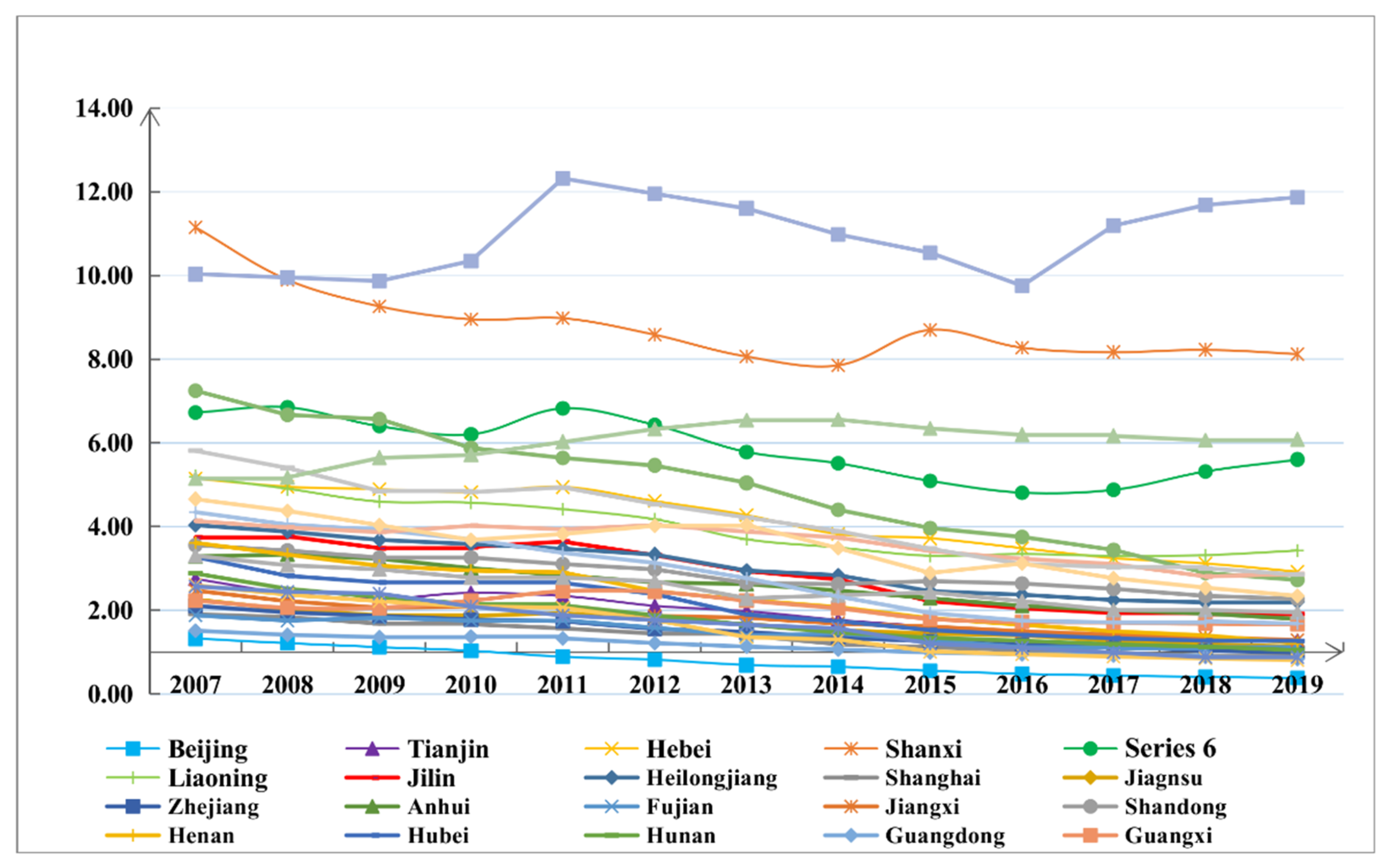
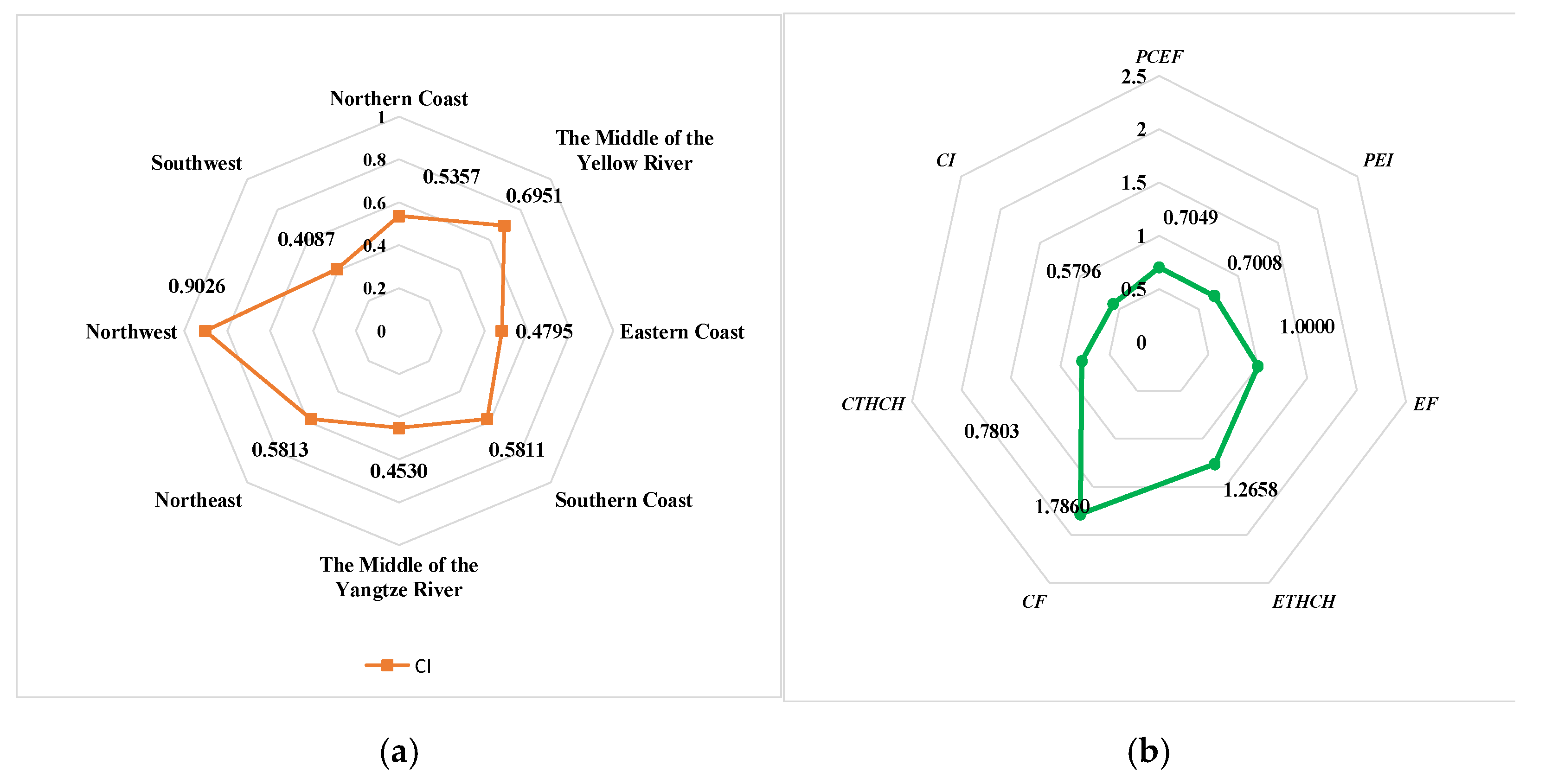
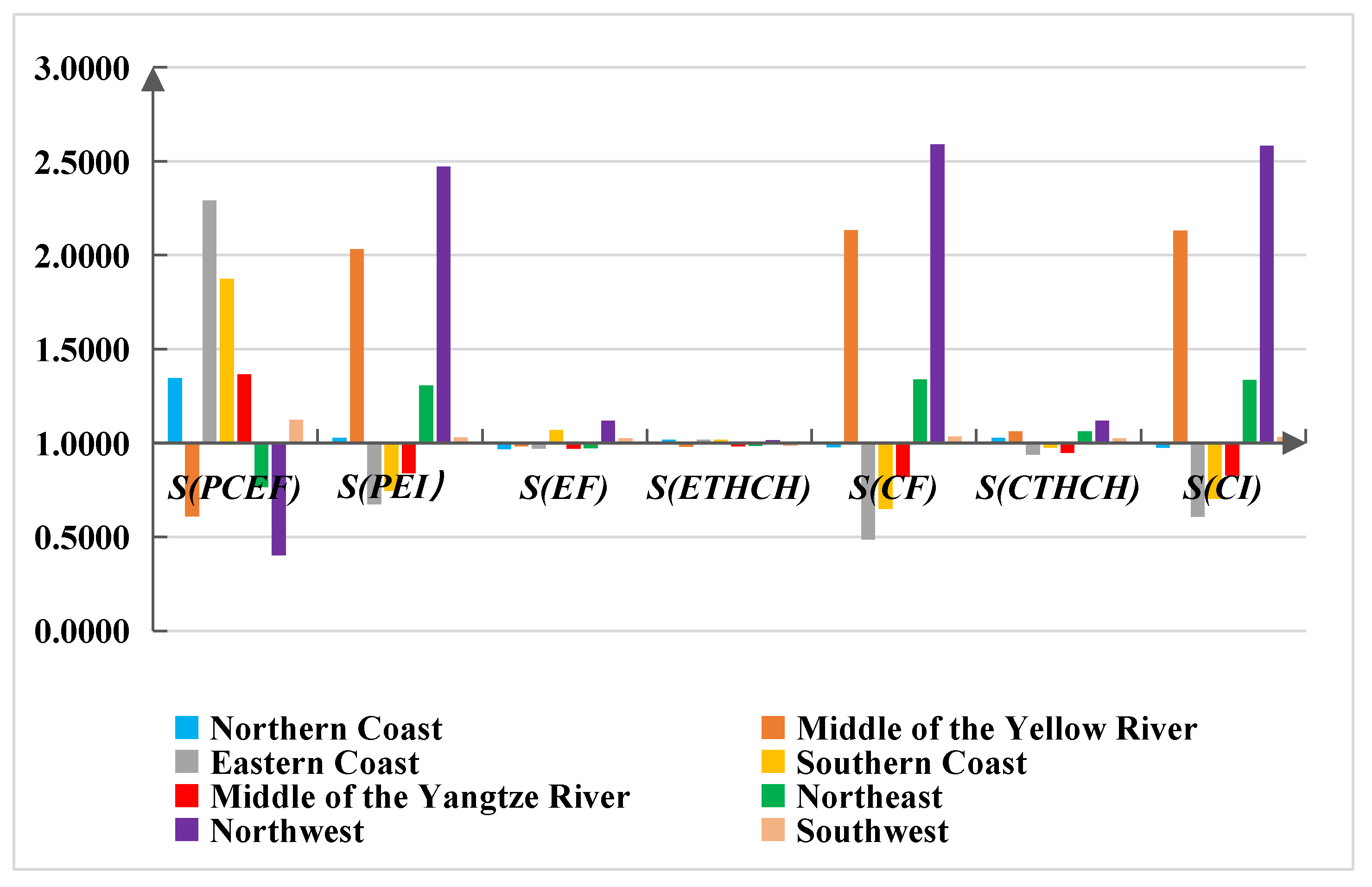


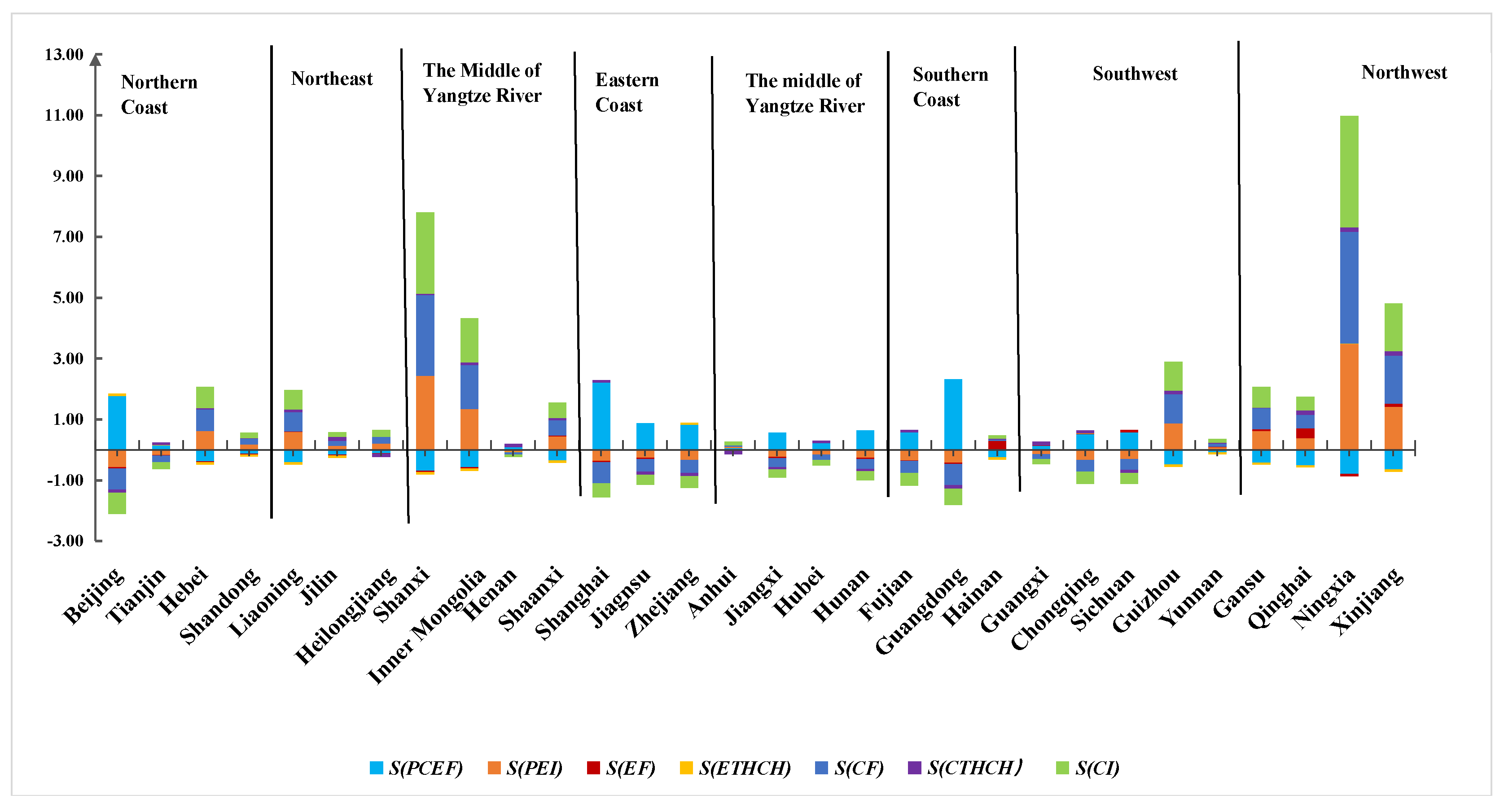

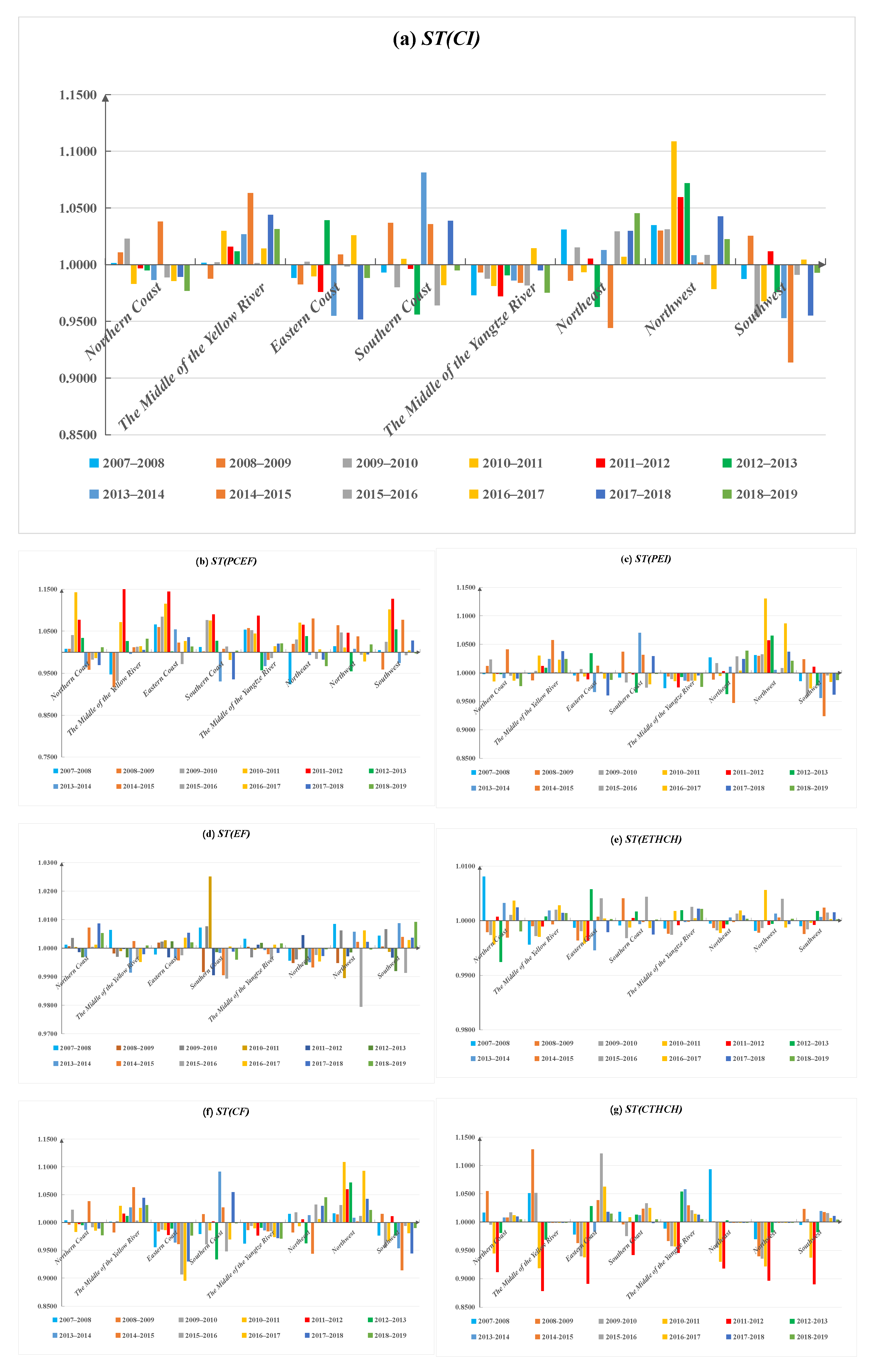
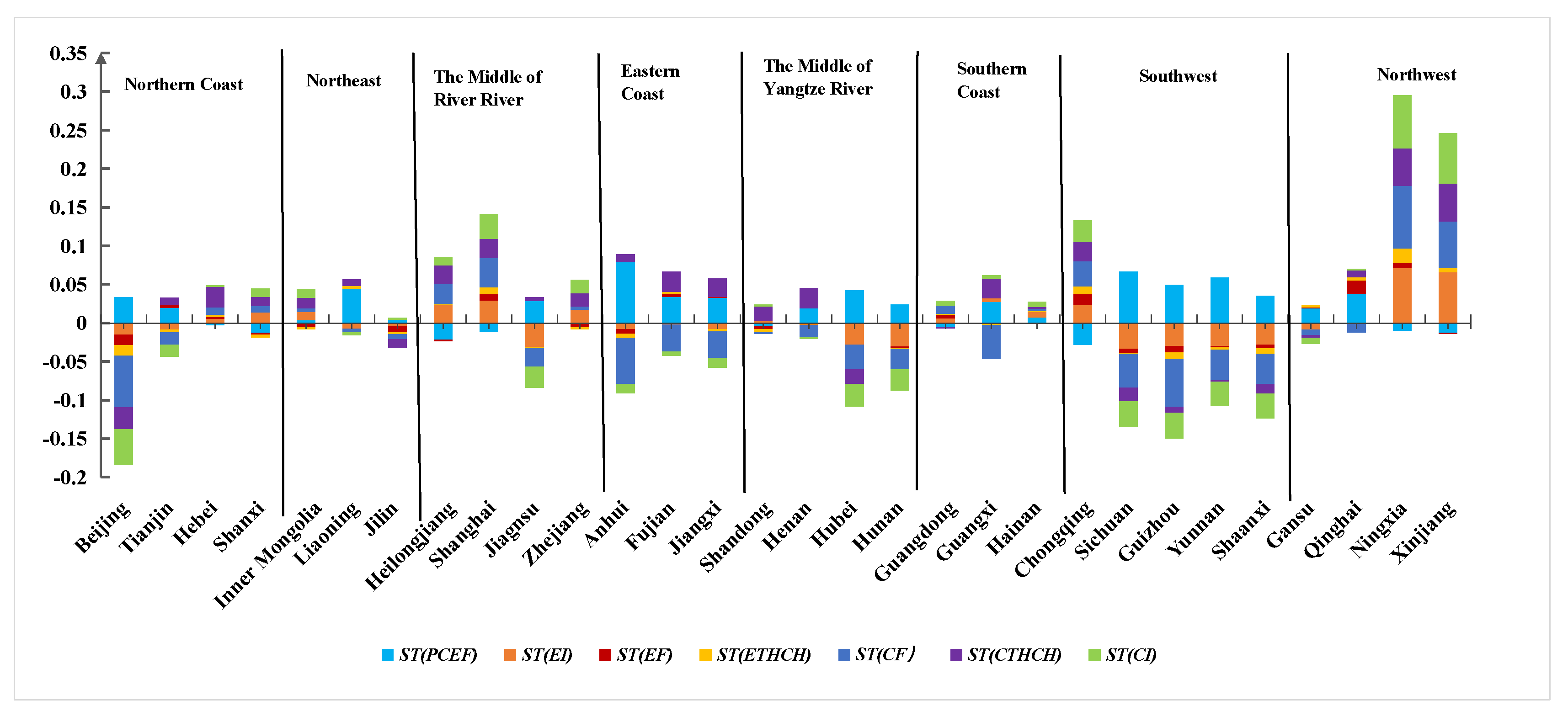
Publisher’s Note: MDPI stays neutral with regard to jurisdictional claims in published maps and institutional affiliations. |
© 2022 by the authors. Licensee MDPI, Basel, Switzerland. This article is an open access article distributed under the terms and conditions of the Creative Commons Attribution (CC BY) license (https://creativecommons.org/licenses/by/4.0/).
Share and Cite
Liu, X.; Chen, H.; Peng, C.; Li, M. Assessing the Drivers of Carbon Intensity Change in China: A Dynamic Spatial–Temporal Production-Theoretical Decomposition Analysis Approach. Sustainability 2022, 14, 12359. https://doi.org/10.3390/su141912359
Liu X, Chen H, Peng C, Li M. Assessing the Drivers of Carbon Intensity Change in China: A Dynamic Spatial–Temporal Production-Theoretical Decomposition Analysis Approach. Sustainability. 2022; 14(19):12359. https://doi.org/10.3390/su141912359
Chicago/Turabian StyleLiu, Xiaolei, Heng Chen, Cheng Peng, and Mingqiu Li. 2022. "Assessing the Drivers of Carbon Intensity Change in China: A Dynamic Spatial–Temporal Production-Theoretical Decomposition Analysis Approach" Sustainability 14, no. 19: 12359. https://doi.org/10.3390/su141912359
APA StyleLiu, X., Chen, H., Peng, C., & Li, M. (2022). Assessing the Drivers of Carbon Intensity Change in China: A Dynamic Spatial–Temporal Production-Theoretical Decomposition Analysis Approach. Sustainability, 14(19), 12359. https://doi.org/10.3390/su141912359







